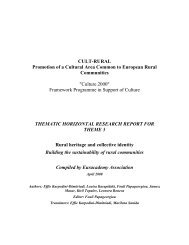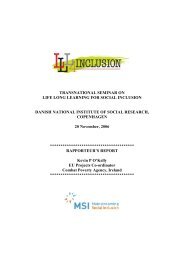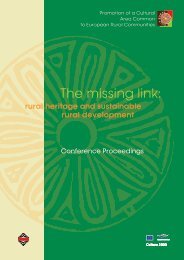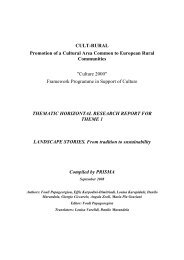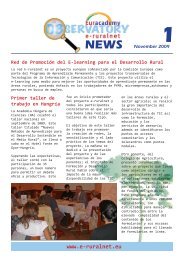ÐÐ¾Ð´Ð°Ñ Ð¿Ð¾ изложбаÑа - cult rural - Prisma
ÐÐ¾Ð´Ð°Ñ Ð¿Ð¾ изложбаÑа - cult rural - Prisma
ÐÐ¾Ð´Ð°Ñ Ð¿Ð¾ изложбаÑа - cult rural - Prisma
Create successful ePaper yourself
Turn your PDF publications into a flip-book with our unique Google optimized e-Paper software.
RITES OF PASSAGE<br />
MARRIAGE RITUALS<br />
Marriage belongs to the rites of passage that have a special weight for the<br />
life cycle of persons in a given society due to the fact they that manifest the<br />
transformation of relations of people who commence a new cycle in their lives.<br />
As a rite, it produces effects beyond the moment of union which have a social<br />
impact. Thus all the ritual actions reproduced during the marriage have a special<br />
meaning and their signifi cance is consciously or unconsciously recognized.<br />
Many bridal traditions and rituals, still today observed, draw their origin from the<br />
past when evil spirits were believed to rule people’s existence, being envious of<br />
happiness and awaiting every chance to attack people’s joy and good fortune.<br />
Therefore, the bride and groom should be protected in order to ensure happiness.<br />
Music, singing and dancing were an attempt to drive away these spirits by the<br />
noise they produce.<br />
In Greece, marital customs are diverse, due to their close link with local traditions<br />
and regional <strong>cult</strong>ural identity or with the special character of the community that<br />
created or perpetuates them. However there are some common elements which<br />
compose the nucleus of the custom despite the variations.<br />
In every traditional Greek marriage there are three main parts to be distinguished:<br />
the preparatory rites, the wedding ceremony and the week after the wedding with<br />
the ritual extensions.<br />
The preparatory rites include the invitation to relatives and people from other<br />
villages to attend the wedding ceremony. It was announced in several ways,<br />
mainly by sending young boys as emissaries. They usually held baskets<br />
with fruits, nuts, candies made from sesame seeds and honey (melekouni or<br />
sesamomeli) or drinks and sang traditional songs inviting people to attend the<br />
event (today invitations have a printed form).<br />
A fertility symbol is also the bridal bread, which represents fruitfulness and is<br />
said to bring good luck and health to the couple. The traditional wedding day is<br />
full of symbolism. Both parties are dressed in separate homes. Relatives and<br />
close friends assist the bridegroom to get shaved and dressed with new cloths,<br />
usually traditional ones. Young girls assist the bride to wear the traditional<br />
wedding costume embroidered with bright colours aiming to protect her from evil<br />
spirits and demons. The purpose of the bridal veil is the same; it was believed to<br />
protect the bride from the evil eye of an ill-wisher. Relatives of opposite families<br />
adorn the bride with gifts of gold jewellery. Local musicians play traditional folk<br />
music. Generally speaking and depending on the local tradition, the wedding<br />
takes place in the bride’s village. A band escorts the groom to the church and<br />
another band retrieves and walks the bride. When the bride is getting ready to<br />
leave the house, relatives from the bridegroom’s side come to receive her from<br />
her father and walk her to the church. The man on a horse holding the flambouro<br />
(wedding banner) is usually in front of the group.<br />
The flambouro, one of the most important wedding symbols in many Greek<br />
areas, is a flag made usually by a big square piece of red cloth put on a long<br />
wooden staff and decorated with different elements according to the local<br />
tradition. In Macedonia they use kerchiefs to adorn it; in some places they put<br />
on it a pomegranate, a symbol of fertility, or fruits (always there in number).<br />
72. Wedding parade in Karpathos (phot.<br />
V.Voutsas)<br />
73. Decorated wedding breads<br />
“bonbonnières” from Crete, Greece<br />
38<br />
72. 73.<br />
74. “Flambouro”, the wedding fl ag of<br />
Sarakatsani, Greece




